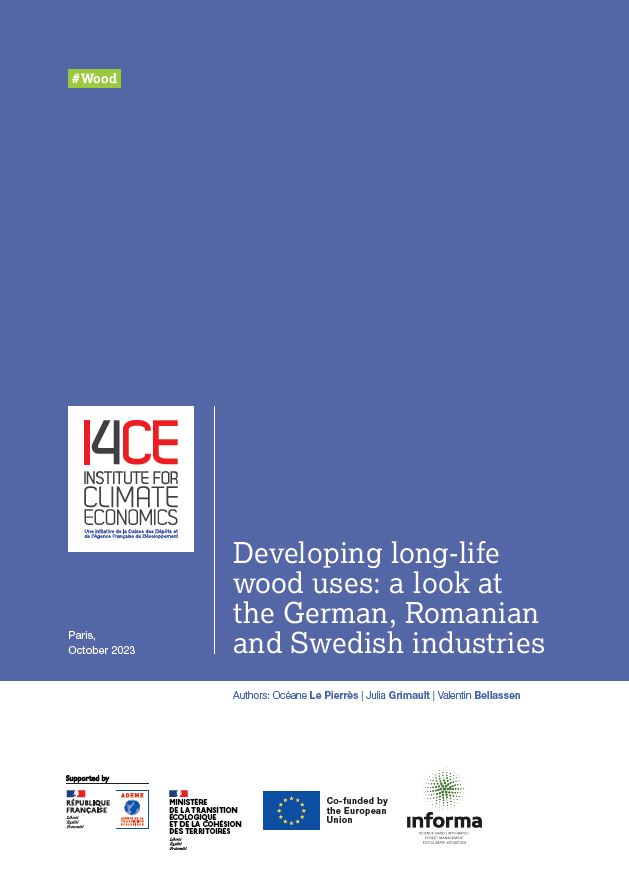Developing long-life wood uses: a look at the German, Romanian and Swedish industries
Achieving carbon neutrality will require the redirection of harvested wood towards long-life uses
To achieve carbon neutrality, France is relying on its carbon sink to balance residual emissions in 2050. A smaller carbon sink would require even greater emissions reductions from other sectors (transport, agriculture, industry, etc.), sectors in which France is already calling for drastic sixfold cuts between 1990 and 2050. In a context where the carbon sink in ecosystems is already falling sharply due to an increase in tree mortality, preserving this sink and developing carbon storage in wood products must be a major concern of the national climate policy.
One of the main drivers for maximising the carbon sink is to optimise the use of harvested wood, by redirecting more wood towards long-life products. This lever is the cornerstone of the “carbon sink” component of the French National Low-Carbon Strategy(*1). The targets for redirecting the use of wood are very ambitious, but while the final figures are still being debated, this lever will have to be activated in any case if we want to achieve our carbon sink targets.
To achieve this objective, three kinds of wood products require development, all within the construction sector: engineered wood, structural panels and insulation materials derived from pulpwood. These products are the key targets because they can be made from low quality or small-diameter wood, which is currently mainly used for short-life applications such as energy and paper pulp. The task that remains is to identify the political and industrial levers for developing these products: our analysis marks the start of this work.
Is the grass greener in neighbouring countries? In search of best practice in German, Romania and Sweden
Do some countries get more out of their wood, particularly by manufacturing long-life wood products? If so, how can this be explained? To answer these questions, we began by identifying European countries that dedicate a larger proportion of their wood harvest to long-life products in comparison to France. Germany, Romania and Sweden were chosen, each for different reasons. The main motive for selecting Germany was that, more so than France, its wood harvest is used more as a material than as an energy source, and it has a very high level of wood-based panel production. Romania was chosen because of the proportion of harvested wood used as a material despite the high proportion of hardwood in its harvest(*2), unlike France where deciduous trees are abundant but fuelwood accounts for the majority share. As for Sweden, its ability to use almost all of its harvest for material uses rather than for energy, as well as the significance of timber-framed buildings further supports its selection.
For each country, the study is divided into two parts:
- An inventory of wood uses in the country concerned, with the aim of highlighting the segments of the industry that perform better than their French counterparts, by obtaining proportionally more long-life wood products from the resources available. The wood harvest is then analysed, with a focus on the uses of hardwoods, of low-quality and small-diameter wood, and of so-called “secondary” resources (wood processing by-products, recovered wood), likely to be redirected from short uses to long-life wood products.
- An analysis of the factors that may underlie the better performances identified in part one, and a discussion of their reproducibility in France. This analysis is based on over fifty published bibliographical references and on the opinions of around twenty experts from these countries.
Main lessons for France
From these comparisons, we have identified three main inspirational levers for France.
1. Subsidizing long-life uses
Firstly, key wood products can be made more competitive than other construction materials. Germany, for example, subsidizes bio-based insulation (including wood fibre insulation) to cover half of the additional cost of the original product. It obtained a derogation from the European Commission to grant this state aid, on the grounds that it was environmentally beneficial. In the twenty years since the subsidy was introduced, the volume of bio-based insulation products entering the German market has seen a fiftyfold increase. Moreover, the cost to the public purse has remained moderate: the economies of scale achieved by bio-based insulation manufacturers have enabled subsidies to be discontinued while maintaining production.
The average Swede uses 360% more sawn wood than their French counterpart. This difference is mainly due to the renovation and extension of buildings. New construction is also a major driver, due to the fairly widespread use of timber frames for single-family homes, as well as for 20% of multifamily homes. However, this striking feature does not offer any obvious lessons for France. Firstly, because the greater use of timber frames seems to be mainly cultural. Secondly, because this practice is based on an adapted and abundant coniferous resource, a factor that would be difficult to replicate in France in the short term (I4CE, 2022). For medium and high-rise buildings, fire regulations are slightly more favourable in Sweden than in France, and an ad hoc national strategy has been implemented to support the expansion of the market, which began in the 1990s. While this strategy seems to be paying off, given the current market share of wood in this type of building, we would point out that even in this favourable environment, the Swedish market has been slow to evolve.
2. Ensuring public policies prioritize wood use
Secondly, it is possible to reduce the pressure from other uses, such as energy or paper, that compete for the same resources. At a constant level of harvesting, growth in one of these sectors or in the panels sector will be detrimental to the others by creating tension in the wood supply. In Romania, there is no paper industry while the panels sector is important. In Sweden, the efficiency of heating networks reduces the energy use of harvested wood, although this actually benefits paper rather than panels. In Germany, energy companies use recovered wood and panel manufacturers use wood raw material, whereas in France it is the energy companies that can afford wood raw material, while panel manufacturers have turned to cheaper recovered wood. Beyond the type of resource used, this last case shows the impact of different policy choices, one directed towards industry which has encouraged the development of panel production, and the other geared towards energy. These three examples illustrate the just-intime relationship between these uses that compete for the same resource: even partial monopolization of the resource by one of these uses has an impact on the others.
Supporting these three sectors is possible by increasing harvest while reducing the forest carbon sink. In France, the strategy is to increase the level of harvesting while reducing the proportion of wood dedicated to the shortest uses. However, France’s policy of heavily subsidizing energy use, including from primary resources, undoubtedly places it in a less favourable situation than the three countries studied here, in terms of the availability of small-diameter and low-quality wood for long-term uses. While our study was unable to identify effective prioritisation policies, the three examples above illustrate the need to establish tradeoffs and prioritise certain uses.
3. Developing the furniture sector to boost the supply of semi-finished products
Finally, the existence of outlets is clearly a structuring factor. As far as the panel industry is concerned, maintaining its production rate depends on the ability to sell its stock. The lack of outlets for panels can limit the smooth running of
factories; securing suitable outlets is therefore imperative if we are to increase production significantly. For example, a lack of outlets for engineered hardwood products in Germany, proved to be a limiting factor for Pollmeier sawmill’s development of this semi-finished product. Here again, our study was not able to identify any effective policies for creating such outlets, apart from the German subsidy (see lesson 1). However, we note that the furniture industry relies on panels in Germany and Romania, and on engineered wood in Romania. The French furniture industry also consumes panels, but some of the furniture and panels used in production are imported. Although furniture is a less sustainable use than construction and renovation, it can help to scale up the production of these products, which can also be used in construction.
This report describes these three main lessons, as well as analyses other positive observations. For example, the study of Germany and Romania revealed industrial models that differ from the French one. The vertical integration of sawyers and panel makers on the same sites in Germany is one factor that makes them competitive. Similarly, the development of engineered wood for furniture in Romania is a promising trend, with no equivalent movement in France at present.
*1: I4CE. Grimault, J., Tronquet, C., Bellassen, V., Bonvillain, T., Foucherot, C., 2022. “Carbon sinks: is France’s ambition realistic?”
*2: As shown in Figure 3, Portugal also has a very high proportion of hardwoods. However, Romania was chosen because the species it harvests (mainly beech and oak) are similar to those harvested in France, while the main hardwoods harvested in Portugal are eucalyptus and cork oak.
For more information on wood types and their main uses in France, please consult our report Changing Wood Use to Improve Carbon Storage: Which Products Should Be the Short-Term Focus? (2022)
[/bloc_bleu]



